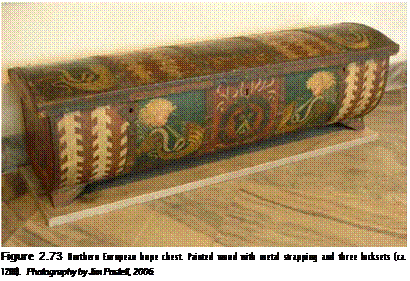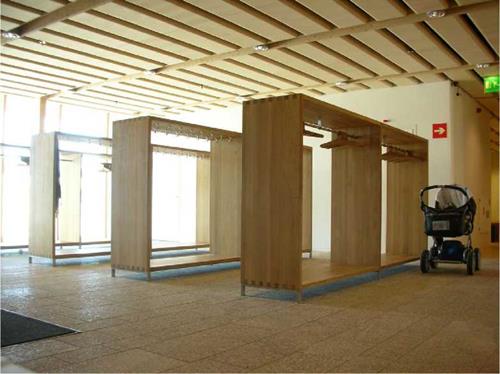The significance of a container is often related to the significance of its contents. It is not surprising, then, that the quality and value of jewelry and other personal collections are expressed by the design and material of their containers. The design and fabrication of a flat-file can express the importance of drawing equipment and paper supplies (Figure 2.72) by the quality of its workmanship. Hope chests (wedding chests) were made to store the dowries of young women, and often were personalized and crafted with care. They were one-of-a-kind pieces that projected a narrative or allegory through form, material, ornamentation, or decoration (Figure 2.73). Though not strictly considered furniture, Japanese sake casks are remarkable for their craft and workmanship (Figure 2.74). The workmanship of these wooden casks reinforces the importance placed on the communal ritual of opening and consuming sake.
Storage and wardrobe furnishings (armoires) can be sizable. The congregation at Viikki Church in Helsinki, Finland, had need for substantial coat storage, which easily could have overwhelmed the entry vestibule and gathering space of the church, designed by JKMM Architects in 2005. Freestanding coat closets (Figure 2.75) were designed without fronts and backs to maintain lines of sight throughout the lobby area when not in use.
Shelving Systems
 |
 |
One of the intended purposes of shelving is to maximize accessibility to stored material (in most settings). Adjustability, structural integrity, visibility, and aesthetics are further design considerations. Shelving systems can be wall-mounted or freestanding. Typically, shelving systems are modular. Due to their large size, they can have a significant influence on the experience and spatial composition of interior space (Figure 2.76).
|
Figure 2.75 Open storage units designed by JKMM Architects (2005), for Viikki Church, Helsinki, Finland. Photography by Jim Postell, 2006. |
|
Figure 2.76 Library shelving within the Bartholomew County Public Library, Columbus, Indiana. Designed by I. M. Pei (1969). Photography by Jim Postell, 2004. |
ENDNOTES
1. Gisela M. A. Richter. Ancient Furniture: A History of Greek, Etruscan and Roman Furniture (Oxford: Clarendon Press, 1926).
2. Ibid.
3. KnollStudio, Eero Saarinen Collection brochure (2009), p. 2.
4. Sources that indicate heights for tables and counters include: Francis D. K. Ching, Interior Design Illustrated (New York: Van Nostrand Reinhold, 1987), pp. 64-69; Maryrose McGowan and Kelsey Kruse, Interior Graphic Standards (Hoboken, NJ: John Wiley & Sons, 2003), p. 173; and Henry Dreyfuss Associates, The Measure of Man and Woman, revised edition (New York: John Wiley & Sons, 2002), pp. 25-28.
5. National Institute for Occupational Safety and Health Web site (Relevant Anthropometric Measures) and Wikipedia, the free online encyclopedia, "Design and Ergonomics": http://en. wikipedia. org/ wiki/Chair—Wikimedia Foundation Inc., February 2007.
6. Wikipedia, Tatami: http://en. wikipedia. org/wiki/Tatami.
7. Katie Weeks, "Slow and Steady," Contract Source Guide, Contract Magazine, 2006, p. 42. Nielsen Business Publications, USA.
8. Action Office brochure by Herman Miller.
9. Many office workstations are systems-based. Herman Miller, Steelcase, Hayworth, Knoll, and Vitra offer a variety of furniture systems designed as components that can be configured and arranged in a number of ways.
10. Environment and Art in Catholic Worship (EACW) is a provisional draft statement by the Bishops Committee on Liturgy (BLL), Washington: published by the National Conference of Catholic Bishops (1978).
11. "Ambos," Encyclopedia Britannica, vol. 1 (1972), p. 719.
12. R. J. Zwi Werblowsky and Geoffrey Wigoden, eds., The Oxford Dictionary of the Jewish Religion. (Oxford: Oxford University Press, 1997); and Ellen Frankel and Betsy P Teutsch, The Encyclopedia of Jewish Symbols (Northvale, NJ: J. Aronson, 1992).
13. Martin Frishman and Hasan-Uddin Khan, The Mosque: Islam and the Form of the Mosque (New York: Thames and Hudson, 1994), pp. 35-37.
14. Clifford Musgrave. Adam and Hepplewhite and Other Neo-classical Furniture (London: Faber and Faber, 1966), p. 202.





